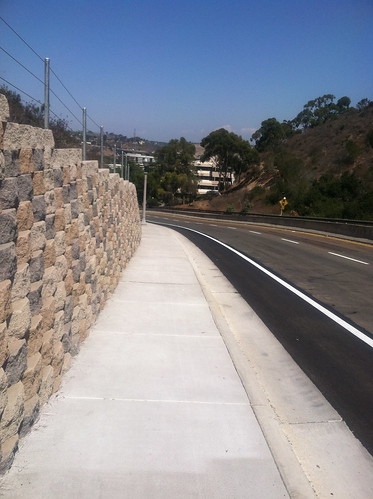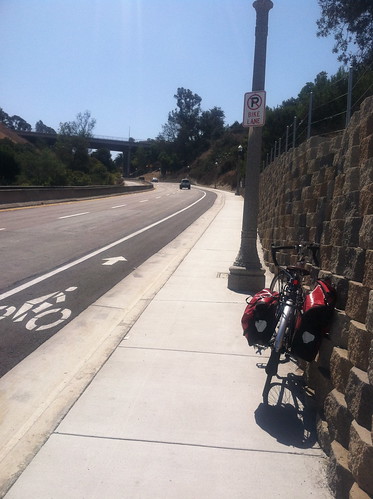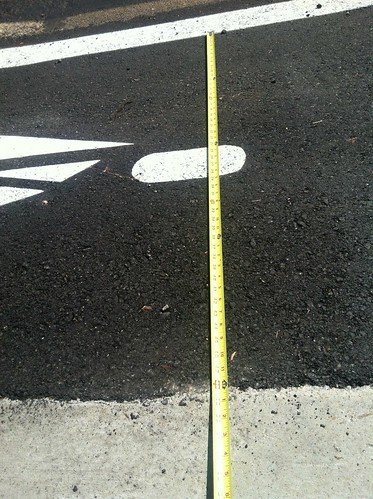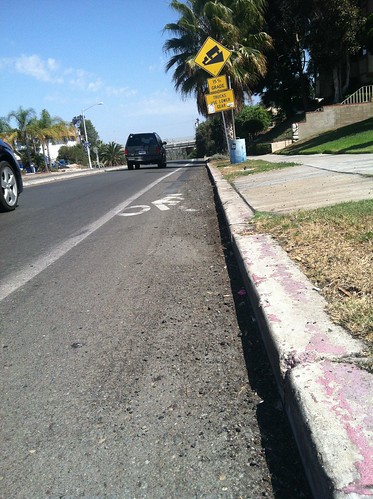Texas Street Southbound Bike Lane Project Complete; Northbound Section Needs Some TLC
Savannah Russell wrote in to state,
I have been thrilled to see the improvements on the Texas Street hill, so I thought I would share them! I finally remembered to stop and take some pictures. I kept getting so excited to ride it that I would forget the pictures! Ha.The retaining wall, drainage ditch, sidewalk, lamps and bike lane are all in place. The bike lane was repaved and is fantastic. The bike lane is a great width, feels very safe while riding up it and the new road paving is level with the gutter paving. It is great! The 15 lamps that have been installed have not yet been hooked up to the grid though so it is still dark at night. I emailed Bob Lathrop, the project manager for this project, several times throughout the process and he was very friendly and always got back to me quickly. My most recent email to him was in regards to the lights and he said they should be on within the next 2-3 weeks. It all depends on when SDG&E gets around to it.Lights or no lights, it is currently a MUCH nicer ride than it was previously. The lights will definitely be a great addition though!
Savannah sent in the following two images of the new southbound (and uphill) bike lane that was recently completed on Texas Street that has a 10% grade.


Earlier last month I contacted Penny Gray, the Bicycle Program Manager at Caltrans HQ in Sacramento to ask about what the existing standards were on bike lanes, or what is called “Class II” bikeways. She responded stating (in part),
The Highway Design Manual Section 300 discusses the requirements for Class II Bikeway Lane Widths.
The Highway Design Manual Section 300 (see link below) discusses the requirements for Class II Bikeway Lane Widths.
“(1) General. Class II bikeways (bike lanes), for the preferential use of bicycles, may be established within the roadbed nd shall be located immediately adjacent to a traffic lane as allowed in this manual. Typical Class II bikeway configurations are illustrated in Figure 301.2A. A bikeway located behind on-street parking, physical separation, or barrier within the roadway is not a Class II bikeway (bike lane); see Index 1003.1 Class I Bikeway (Bike Path) for standards and design guidance. The minimum Class II bike lane width shall be 4 feet, except where:
Adjacent to on-street parking, the minimum bike lane should be 5 feet.
Posted speeds are greater than 40 miles per hour, the minimum bike lane
should be 6 feet, or
On highways with concrete curb and gutter, a minimum width of 3 feet
measured from the bike lane stripe to the joint between the shoulder
pavement and the gutter shall be provided.Class II bikeways may be included as part of the shoulder width See Topic
302.”While the Streets and Highways Code Section 891 states “All city, county, regional, and other local agencies responsible for the development or operation of bikeways or roadways where bicycle travel is permitted shall utilize all minimum safety design criteria and uniform specifications and symbols for signs, markers, and traffic control devices established pursuant to Section 890.6 and 890.8”, many cities and counties use their own standards and designs based on engineering standards, etc. As a result, you may find many bike lanes that do not conform to the state standard.
Since Caltrans is intent on turning all bike riders and advocates into amateur civil engineers, I took a tape measure with me when I rode over to Texas Street to check out the new improvements. The new southbound section of Texas Street measured exactly 4 feet per the existing standards listed in the highway manual and not an inch more. Thankfully, the gutter provides a bit of a buffer from pedestrians who want to walk down into Mission Valley.

While the progress on Texas Street was ongoing, I had contacted Jake Aquino who works for the Bicycle Program at the City of San Diego to ask about adding a painted buffer to protect bicycle riders from fast moving motor vehicles. Aquino responded stating (in part),
Buffered bike lanes would reduce the effective bike lane from fix feet to four feet with a two feet buffered lane. Also, the proposed two feet gutter would further reduce the effective bike lane from four feet to two feet. Two feet of effective bike lane is undesirable so we cannot recommend the installation of buffered bike lanes at this time
While Aquino only focused on the bike lane width, he should have considered restriping the vehicle lanes in order to transform Texas Street from a speedy thoroughfare to a traffic calmed street. In a 2005 Caltrans publication titled Main Streets: Flexibility in Design and Operations(pdf), I quote an excerpt on reducing lane widths:
Reduced lane widths in combination with other traffic calming measures may encourage slower speeds, which is desirable for a main street. Where existing right of way is limited, reducing lane widths can provide adequate shoulder width for bike lanes and sidewalks.
As San Diegans are more than aware, we have three north/south freeways that connect the mid-city community to the rest of the city: the SR-163, the I-15 and the 805. A speedy thoroughfare (such as freeways) that is designed to reduce conflict with other road users should be promoted to our driving public and surface streets that are known to have other road users should be redesigned to discourage speeding vehicular traffic by implementing traffic calming designs that will be inviting to the the non-driving public and a pleasant (and less noisy) street for the residents.
While the southbound section of Texas Street has been made a little nicer for the bike riding population, the northbound section needs a little bit of maintenance work:

The northbound (downhill) section of Texas Street has a bike lane does a very effective job of collecting road debris and the the bike lane width (including gutter) is less than four feet wide. The city should consider restriping this section of the bike lane on Texas Street and making it a bit more beautiful and inviting than it currently is.
For more photos of Texas Street’s bike lanes, see this photo set on flickr.
What are your thoughts about the new southbound bike lane on Texas Street? Would a buffer help?
